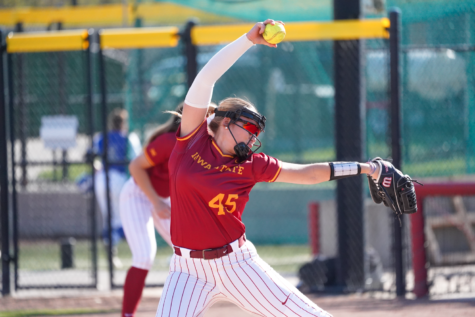Red Raiders passing attack might test Cyclones
Photo: Manfred Brugger/Iowa State Daily
Iowa State’s David Sims goes for a tackle against Kansas State on Sept. 18 at Arrowhead Stadium.
September 29, 2010
ISU safety David Sims and the rest of the Cyclone secondary are going to get the opportunity they’ve been waiting for Saturday.
Texas Tech comes into Jack Trice Stadium, averaging 275 passing yards a game, fourth in the Big 12.
“We really haven’t been tested yet,” Sims said. “I’m ready for this. We’ve all been waiting for this opportunity to show what we’ve got and what we’ve been working on all season.”
While the Red Raiders’ offense is more balanced than under former coach Mike Leach, new coach Tommy Tuberville has quarterback Taylor Potts dropping back to pass 60 percent of the time.
The pace of the offense is something the ISU defense is going to have to get used to, as it is much faster than their previous opponents.
“They’re going to throw the ball first,” said defensive coordinator Wally Burnham. “Then they’ll run the ball when they think they’ve got us worn down with that fast-paced offense.”
Sims knows there are adjustments that they must make in order to keep up with the more talented passing attack.
The changes are going to come with both Burnham and coach Paul Rhoads’ philosophy of keeping everything in front on defense.
“We need to work on actually finishing the play and disguising what were doing,” Sims said. “We have to know what our receivers are doing at all times and make sure our eyes are in the right place.”
Texas Tech’s receiving corps is led by senior Lyle Leong.
Leong has recorded 20 receptions for 250 yards and six touchdowns through their first three games of the season.
Potts has thrown six of his eight touchdown passes to Leong, with the other two going to senior Detron Lewis and sophomore Austin Zouzalik.
“They still got some great receivers,” Burnham said. “They got speed. They play four just about every snap, sometimes five. They got two good running backs and the quarterback is a pretty good football player.”
Potts stands at 6 feet 5 inches, 222 pounds, but Burnham said that makes him about 6 feet 8 inches by the time he releases the ball.
To keep the receivers in check, the secondary is going to have to jam the receivers off the line and not them get into their routes easily.
“They’re going to run some deep routes that they’re going to be involved in in front of them as well as behind them,” Burnham said. “They’re going to challenge us. The corners and safeties are going to have to do a good job on deep balls and make tackles in the open field.”
The defense showed its explosiveness, scoring twice on the strength of two interception returns for touchdowns against Northern Iowa.
Rhoads said the key to the defensive line playing well against Northern Iowa was the level of coverage the secondary put on their receivers. This allowed the lineman and linebackers to get pressure on the quarterback.
Along with safeties Sims and Michael O’Connell, cornerbacks Ter’Ran Benton, Jeremy Reeves and Anthony Young are stepping into the spotlight in the secondary.
“Jeremy is a competitor,” said secondary coach Bobby Elliott. “He can run and jump and do all those things and Jeremy has had some good ball games. He’s played pretty consistent all the way through.”
Linebackers Jake Knott and A.J. Klein have also displayed soft hands in the previous games and offer a hybrid-type threat for the defense.
The duo’s impressive and consistent play is going to be key against an offense like Texas Tech’s, and Rhoads wants his team to protect against the “upfield shoulder.”
“One of the things you have to worry about in an explosive passing attack like this is not giving up big plays,” Rhoads said. “You can’t let players get behind you and get the ball in space an go the distance on you.”

















